Infomercial hands." It's a phrase my wife and I use to describe the pose and expression that shows up in the beginning of most infomercials—the ones that start with phrases like, "Are you tired of not being able to pour your soda like a normal human being?" It's always accompanied by footage of people throwing up their hands in disgust after failing to accomplish tasks that most of us can do without any problems.
The Acer Aspire R7 gives me infomercial hands. Constantly.
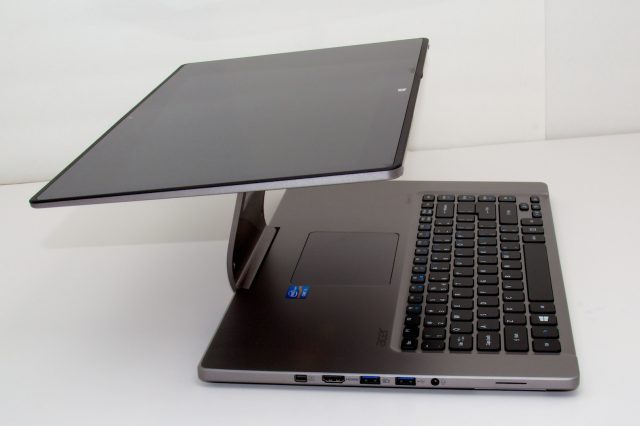
The R7 and its crazy Ezel hinge.
I get that PC OEMs are facing decreasing margins as non-traditional computing devices continue to gain popularity, and I get that there's shareholder pressure to think of the next big thing in the portable space in order to keep revenue up and hit the quarterly guidance. But the Aspire R7 is unfortunately not the next big thing. I'm not entirely sure what it is, really, or what its target market is, or what particular task or tasks it's supposed to excel at that other devices don't already do better.
What hath Acer wrought?
| SPECS AT A GLANCE: ACER ASPIRE R7 | |
|---|---|
| SCREEN | 1920×1080 15.6-inch 10-touchpoint IPS, 141 PPI |
| OS | Windows 8 |
| CPU | 1.8GHz Intel Core i5-3427U (Turbo Boost 2.8GHz) |
| RAM | 6GB DDR3 (upgradeable to 12GB) |
| GPU | Intel HD 4000 (integrated) |
| STORAGE | 500GB 5400 rpm HDD + 24 GB SSD (caching) |
| NETWORKING | Broadcom 802.11b/g/n, Bluetooth 4.0 |
| PORTS | 1x proprietary Acer Converter Port, 1x HDMI, 2x USB 3.0, 1x USB 2.0, 1x eSATA/USB 2.0 combo, stereo headphone/line out/mic combo, Kensington lock port, SDXC card slot |
| BATTERY | 4-cell 3560mAh Li-ion |
| SIZE | 0.81 (at front)/1.12 (at rear) x 14.83 x 10.02 inches, 20.5 mm (at front)/28.4 mm (at rear) x 376.7 mm x 254.5 mm |
| WEIGHT | 5.29 lb/2.4 kg |
| STARTING PRICE | $999 |
| PRICE AS CONFIGURED | $999 |
We got some hands-on time with the Acer Aspire R7 back in early May, when Ars Senior Products Specialist Andrew Cunningham called it "the strangest convertible PC we've ever seen." Having spent a couple of weeks with the device, I can definitely validate that. In the hours I've spent using it, I never grew wholly comfortable with its layout and function, and I came to resent its weight and overall unfriendliness.
The Aspire R7 is a convertible, that bastard product category that became popular with OEMs after the launch of Windows 8. It features a large 15.6" touchscreen mounted on a double-jointed hinge, called the "Ezel Hinge" by Acer's marketers. The Ezel hinges at both ends, allowing the screen to be raised, lowered, and pivoted. The R7 uses its big hinge to convert between a traditional laptop-like appearance, a keyboard-enhanced tablet-like appearance, a supported tablet, and a full hand-held tablet.
The fact that the device has certain set "modes" into which you are supposed to transform it isn't immediately obvious at first, and so Acer has spent quite a bit of time ensuring that customers understand how the R7 works. Its website contains numerous animations showing the R7 merrily flipping back and forth; the device also came with a pack-in piece of paper graphically explaining its different configurations. New users can even click on a video on the different modes embedded in the Task Bar for reference.
Setting aside the hinge and its implications for a moment, the R7 is certainly not awful hardware. It has a dual-core 1.8GHz Ivy Bridge Core i5-3427U, a low-voltage 22nm CPU with hyperthreading, and a max rated TDP of 17 watts. It has 4GB of soldered-in RAM, and the configuration we reviewed came with its one RAM slot filled with a 2GB SODIMM, yielding an odd-but-not-bad total of 6GB. Its integrated Intel HD 4000 GPU is perfectly adequate for non-hardcore-gamer usage. We would have liked to see the new Haswell CPUs make an appearance, but Ivy Bridge isn't a bad performer.
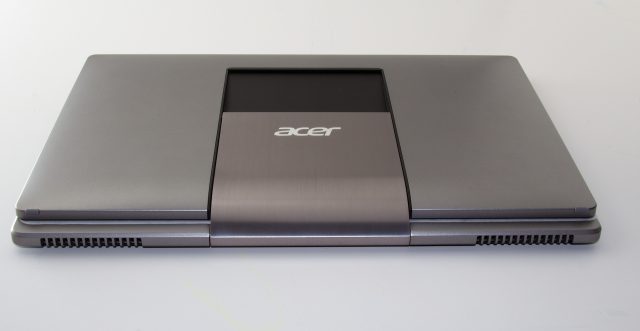
The R7, folded closed and ready for transport.
The laptop/convertible/whatever-we're-calling-these-things defines solidity; it's 5.29 lbs of aluminum, plastic, and glass. The Ezel Hinge and its captive touchscreen lack even a tiny bit of flop or play—the screen moves with balanced authority on the hinge and the hinge in turn pivots against the laptop base with squeak-free smoothness. The screen stayed exactly at whatever angle I positioned it without shifting up or down. In fact, at times it took perhaps too much effort to move the screen, and I'd end up shifting the entire laptop around on its little rubber feet. However, I'd much rather have a hinged display like this sprung on the stiff side than on the loose side.
The display itself is big and bright. The IPS panel supports pretty broad viewing angles, which is important because the R7's shape-changing design means that the screen is likely to be viewed from a wide variety of distances and positions. The LED backlighting was even and without any obvious hot spots or bleeding. Its 10-point capacitive touch layer also gave me no problems—it responded to touches and drags immediately with no noticeable lag.
 Left-side ports: headphone/line-in/mic, 2x USB 3, HDMI, and a proprietary Acer connector that looks like DIsplayPort but isn't.
Left-side ports: headphone/line-in/mic, 2x USB 3, HDMI, and a proprietary Acer connector that looks like DIsplayPort but isn't. Right-side ports: USB 2, SD card, Kensington lock, and power.
Right-side ports: USB 2, SD card, Kensington lock, and power.
Unexpectedly, I like the keyboard. I find myself hating most island-style keyboards, but this one's quite nice. The keys take a tiny amount of effort to depress and then instantly descend their full short length to bottom out authoritatively. There's no sense of mush, thank goodness. And the backlight, though it bleeds out from under the keys, is extremely bright at its max setting.
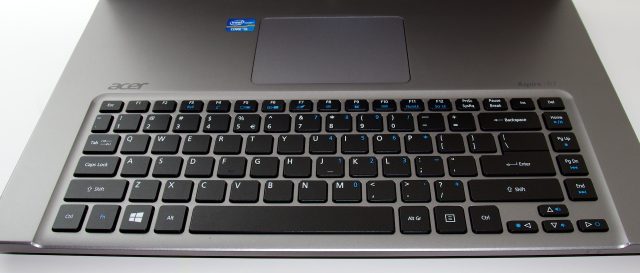
The weirdly inverted keyboard and trackpad arrangement. I did not like this.
There are also some fair-sized (for a portable) speakers on the bottom of the device—a pair of 2W "Dolby Home Theater" branded grilles. The audio coming out of them sounded quite clear at low-to-medium volume. I'm not sure that slapping a "Dolby Home Theater" brand on them means you'd want to use them to listen to a movie at full volume, but for casual listening to streamed audio, they were perfectly fine.
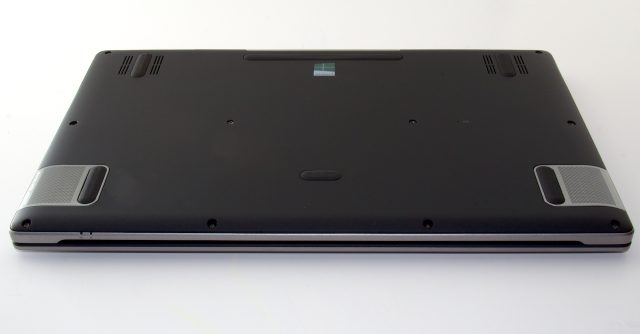
The bottom of the R7, with speaker grilles visible at edges.
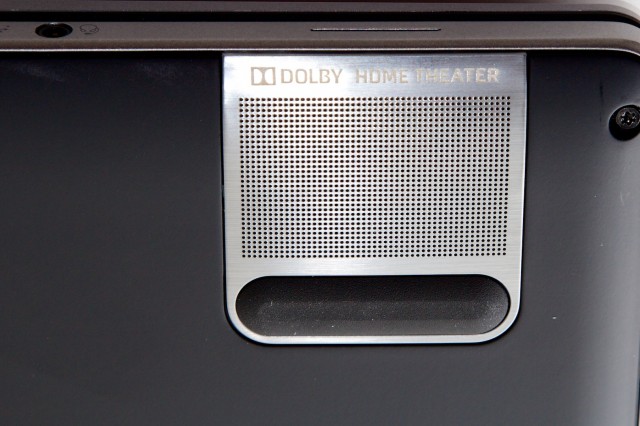
I got the boom-boom under my...computer.
That is unfortunately the end of the positive things I have to say about this device. In daily use it performed adequately, but it definitely isn't going to win any awards for speed. I didn't bother running any structured benchmarks because Ivy Bridge is a thoroughly known quantity at this point; all of its hardware is already well-documented. (You can check our Asus ZenBook Prime and 2013 MacBook Air reviews for hard numbers if you want them.)
The lack of an SSD for its primary operating system didn't make as big of an impact as I thought it would—at least, not at first. The R7 comes with a 500GB 5400 rpm hard disk drive, but it's augmented with a 24GB mSATA SSD that functions as a cache for the operating system boot files and for frequently accessed applications. Subjectively, it was slower than using an SSD but much faster than using just the hard disk drive—which I got to learn a lot about.
But, first, let's talk about the R7's flippy screen and hinge. The issue with the R7 is that although it has four primary "forms," it's not particularly useful in any of them—sort of like how Astrotrain wasn't a very good space shuttle, train, or robot.
Notebook mode
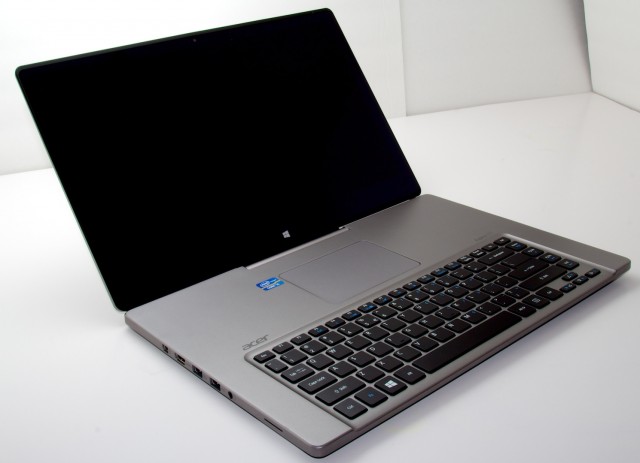
The R7 pretending to be a normal, uncomplicated notebook.
The R7 is a bad fit for a conventional notebook—in fact, several design choices make the device exceedingly frustrating to use. The fact that it weighs almost five and a half pounds (that's about 2.4 kg) makes lugging it around a definite chore. Granted, it's not as heavy as the 7.7 lb HP Elitebook 8770w, but the Elitebook was a miniaturized CAD workstation with gobs of CPU and GPU and RAM—the R7 is a middling-spec semi-portable.
After hauling the R7 to Starbucks, the upside-down arrangement of the keyboard and trackpad quickly caused me to abandon laptop mode. The trackpad is situated above the keyboard, and the keyboard is nearly flush with the front edge of the laptop. This leads to two problems: first, with the R7 in my lap, I couldn't find a comfortable typing position. Mousing was similarly frustrating, since the only place to rest hand or arm while operating the trackpad is squarely on the keyboard. Cue infomercial hands.
Ezel mode
So, I transformed the laptop (ch-ch-ch-ch-ch) to its "Ezel mode," where it looks like a keyboard-equipped tablet:
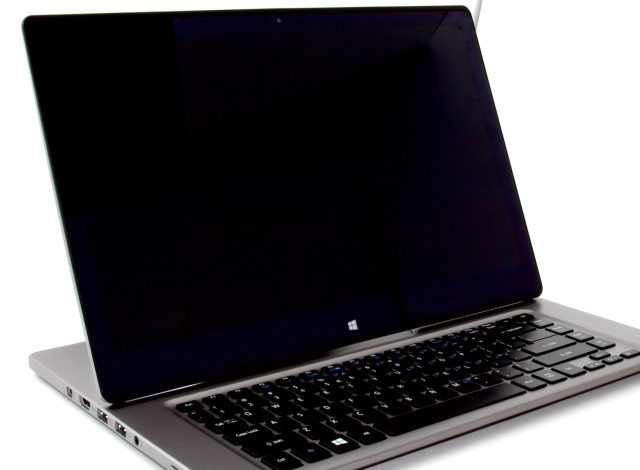
"Ezel mode" hides the trackpad behind the screen and makes the device both easier and more complicated to use.
The logic for positioning the trackpad above the keyboard becomes clear: it's so you can pull the screen forward like this and use the R7 as a tablet-with-keyboard. This doesn't change the fact that the keyboard is still frustrating to use without any appreciable distance between it and the front edge of the laptop, but it does at least save you from the trackpad.
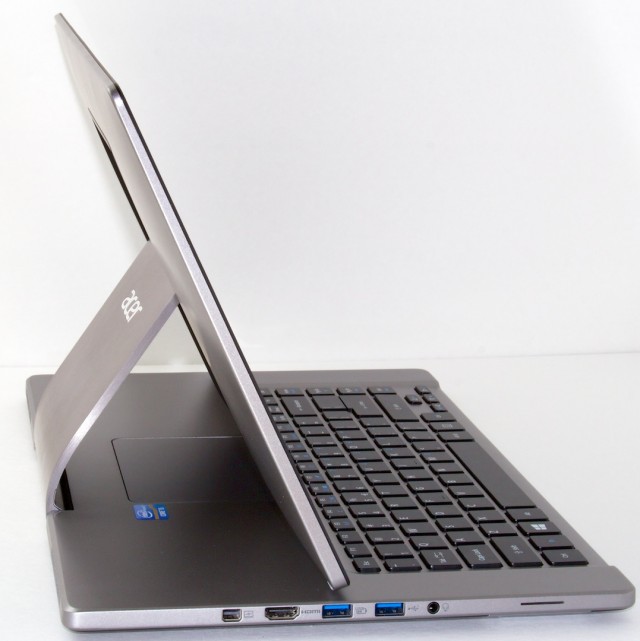
View of Ezel mode from the side.
As an interface device, the touchscreen worked fine. Windows 8 remained Windows 8, with all the good and bad that implies. I gave working in this configuration an honest go, but the majority of the tasks I had to do involved working not in touch-friendly Metro tile land but at the command line and in non-Metro traditional apps instead. Exclusively using the touch screen to interact with non-Metro apps was very hit or miss—not every tap went where I meant for it to go. Infomercial hands.
Display mode
That evening, I sat down at the kitchen table with the R7 while my wife and I watched Archer and tried out the R7 in its "display mode," with the screen floating in the air held by the hinge and the keyboard facing away from me. I could see the use if we'd been actually watching Archer on the R7, but we weren't—we were home, so we were watching it on the much-larger television instead. I browsed the Web for a bit, looking up Archer trivia as we played through our backlog.
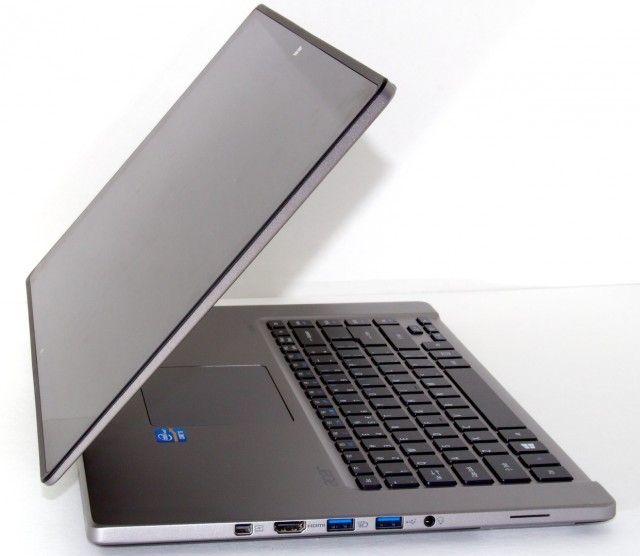
In "Display mode," the display is flipped around and the R7 becomes sort of like a supported tablet or a floating screen. The keyboard and trackpad remain functional, though, and a third party can manage mischief on them.
This was actually the most useful and natural the R7 had felt in the entire time I'd been using it. Its excessive weight didn't particularly matter when it was on the table in front of me, and the screen seemed to float solidly in front of me, not moving or really even wiggling as I tapped it.
However, as I browsed around, I began to notice weird things happening. Webpages would re-load as I was staring at them; extraneous letters would appear in the search fields as I typed. The mouse cursor would slowly drift across the screen and occasionally register clicks seemingly at random.
A muffled giggling revealed the culprit—my darling wife was covertly tapping the occasional key or touching the trackpad as I worked. R7 users take note: when you've got the R7 in support mode like this, the keyboard and trackpad face away from you... And they remain live. Infomercial hands again.
Tablet mode
The R7 can also be used as a full tablet, if you are the Hulk or possibly a gorilla. It is simply too heavy to hold in front of you for extended periods:

Not quite flat: in tablet mode, the screen sits against the hinge, but doesn't rest against the body.
It also doesn't actually fold flush as a tablet either. If you're going to have the R7 flat on a surface and want the screen to fold down, that's one thing; a small bit of elevation might actually be helpful. If you're going to try to hold it and use it for an e-reader, though, it's definitely not the best tool for the job. You'd cramp up in no time. One more time, with feeling: Infomercial. Hands.
The only way to be sure
Upon taking the device out of the box and turning it on, I was reminded very clearly why I try to avoid purchasing commodity portables for personal use: the R7 arrived brimming to the gills with crapware.
As I began to set up to do a battery test, the pack-in version of McAfee kicked off a scan; within a few seconds, the R7's fans had ramped up. I made the mistake of actually clicking on the McAfee logo to see if there was a way of aborting the scan, but this teeny bit of attention only seemed to make the app angrier. It began popping up notifications telling me that I both needed to update it and also to give it my credit card so it could "protect" me.
Infomercial hands.
I thought about uninstalling the app, but I realized that down that road lay madness. In order to get unadulterated, untainted battery life numbers, I nuked the factory load from orbit and reinstalled Windows 8 from scratch. I try not to do this with review hardware, preferring instead to take the devices as they come from the manufacturer, but there was no getting around it here—the factory image was going to prevent me from accurately assessing performance.
This turned out to be, as they say, a mistake. The fresh installation of Windows 8 didn't include the third-party software required to use the SSD caching, and so while I was free of the scourge of McAfee and the other pre-installed crapware, the experience of using the notebook became much, much slower.
Fortunately, a kind soul on Acer's forums posted a procedure to reinstate the SSD's caching capabilities. After only using SSD-equipped computers for so long, actually having to deal with a 5400 rpm hard disk drive was pure torture. The SSD caching restored some pep to the device.
Performance and battery life
After sorting that out, I resumed using the R7 as my daily driver. Subjectively, with caching in place, the R7 performed unremarkably—it was neither terribly slow nor terribly fast. Boot times and standby times were acceptably quick, with UEFI-enhanced booting taking no more than 10 to 15 seconds and cold-standby resumes happening within less than 10.
Frequently-opened applications like the Web browser started speedily enough; newly-installed apps would cause the hard drive to audibly spin up and start grinding, but I seldom noticed any hard disk drive noise once I'd used an app a few times. With caching enabled, I almost never found myself getting ahead of the computer and waiting while the hard drive chugged.
The 6GB of RAM might give some pause, but this can be doubled to a max of 12GB by the installation of an 8GB SODIMM in the single expansion slot. For the light workload I subjected the R7 to, 6GB was more than enough to accommodate me without any noticeable swapping.
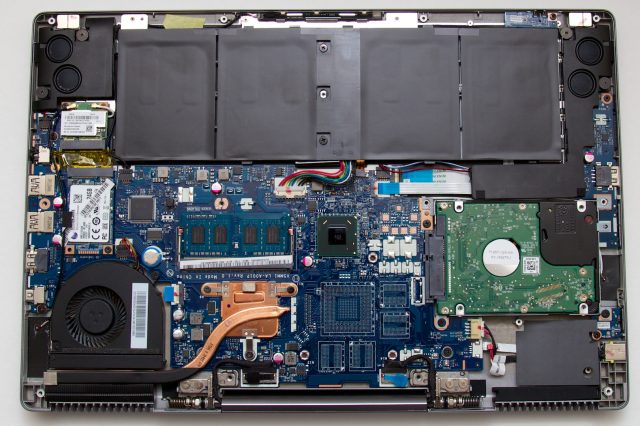 Under the hood—the R7's insides, showing battery, mSATA SSD at left, HDD at right, and the single SODIMM slot.
Under the hood—the R7's insides, showing battery, mSATA SSD at left, HDD at right, and the single SODIMM slot.
From a battery perspective, the R7 lasted for four hours and 15 minutes during a standard workday regime of streaming music, typing, and Web browsing. Given the size of the device's display (which I kept at 50 percent brightness) and the amount of time it spent spinning up and down the fan, this is perhaps not surprising. It's definitely no Haswell Macbook Air.
It’s trying here
The R7 is at least an earnest little all-in-one—it tries, really hard, to give you a lot of neat new ways to interact with your applications and documents. Unfortunately, it doesn't ever really work. It's far too bulky and heavy to be a truly portable portable and far too underpowered to be a good desktop replacement. I suppose it might have a place as something you haul with you from room to room in your house—like, "I'm going to fold laundry for a while, and man, I sure could go for some Downton Abbey while I'm folding." For something like that, it's not at all a bad choice. Find a flat surface, flip the thing around into display mode, and boom, you've got a bright 15.6" display on which to watch the antics of Clan Crawley and their insane servants.
Unfortunately, one good usable configuration out of four does not make a quality device. The much cheaper iPad or other tablet that you almost certainly already own makes a far better screen to carry into a room and prop on some towels while you match up socks. The $999 price of the model as tested is definitely a point in its favor, but it ultimately doesn't do anything that you can't get a dedicated device to do with far fewer frustrations.
In conclusion: Infomercial hands.
The good
- Sturdy construction—signature Ezel hinge is tight and functional
- Bright display with responsive touchscreen
- Price is nice considering the hardware and form factor
- At least moderately upgradeable—HDD could be swapped for 2.5" SSD and RAM can be upgraded
The bad
- Far too heavy to be usefully portable
- Trackpad position is worse than useless
- Keyboard position is awful
- Device is a mismatched nightmare of ergonomics
- Pokey 5400 RPM HDD is helped by caching SSD, but it's still just not that quick
- Battery life isn't great
- Spending money on an Ivy Bridge system is hard to justify now that Haswell is here
The ugly
- The R7 does nothing well and has no compelling reason to exist
No comments:
Post a Comment
Let us know your Thoughts and ideas!
Your comment will be deleted if you
Spam , Adv. Or use of bad language!
Try not to! And thank for visiting and for the comment
Keep visiting and spread and share our post !!
Sharing is a kind way of caring!! Thanks again!